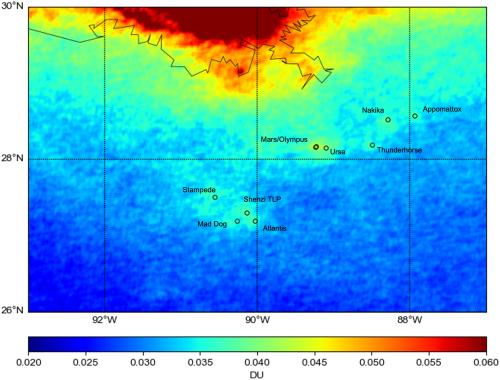Scientists with the Bureau of Ocean Energy Management (BOEM) and the National Aeronautics and Space Administration (NASA) recently published an analysis of nitrogen dioxide (NO2) patterns and trends in the Gulf using satellite data in the AGU’s Earth and Space Science journal. The paper, “Satellite NO2 Trends and Hotspots Over Offshore Oil and Gas Operations in the Gulf of Mexico,” reviewed more than 18 years of NO2 data for three areas in the Gulf Coast region to: identify NO2 hotspots from oil and natural gas (ONG) platforms; establish a baseline for future emissions estimates; and provide a methodology for analyzing NO2 measurements.
BOEM is responsible for managing planned ONG activity on the Outer Continental Shelf. Accurately quantifying these nitrogen oxide emissions is crucial to BOEM’s mission to ensure oil and gas activities do not degrade coastal states’ air quality.
This work is a continuation of BOEM and NASA’s Satellite Continental and Oceanic Atmospheric Pollution Experiment (SCOAPE I) project and provides insight into long-term emissions trends over the Gulf. It also demonstrates the capability of higher-resolution satellite instruments to observe NO2 hotspots and potentially be used to estimate emissions fluxes from oil and gas activities. NASA’s SCOAPE II cruise, planned for June 2024, will validate its new Tropospheric Emissions: Monitoring of Pollution (TEMPO) instrument, which has an even higher spatial and temporal resolution than its predecessors. BOEM researchers anticipate being able to monitor ONG pollution on an hour-by-hour basis throughout the Gulf Region.
This story is part of the “Unleashing the Science” series, showcasing how bureaus within the Department of the Interior produce and apply science to ensure responsible management decisions for our planet now and for the future.
--BOEM--
The Department of the Interior’s Bureau of Ocean Energy Management (BOEM) manages development of U.S. Outer Continental Shelf (OCS) energy, mineral, and geological resources in an environmentally and economically responsible way.


